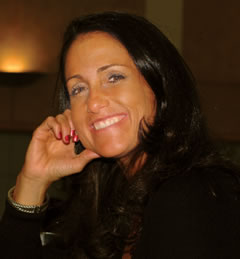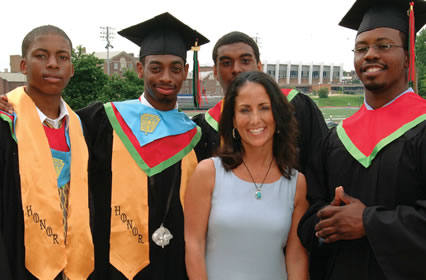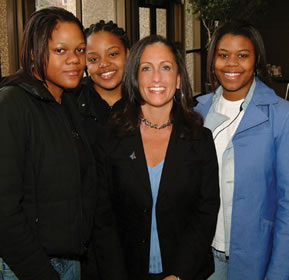|
VERBATIM
Washington Life: How did your career begin? SK : After graduating from American University in 1986, I went to work for the Close Up Foundation, a nonprofit group that brings high school students to Washington to learn about government. With the desire to expand my involvement with youth, I applied to Teach for America and asked to be placed in a high-risk, high school in Los Angeles . Then it occurred to me. Why go across the country when I could just cross the Anacostia River ? So I got a job as an American Government teacher at H.D. Woodson, D.C.'s only 100 percent African-American High School , located in one of the city's most socio-economically challenged neighborhoods. That is when I met my real challenges and inspirations.
SK : The students I met at Woodson are among the most remarkable people I have ever known. Their hope, determination and perseverance in the face of tremendous challenges inspired me. Simultaneously, their limited opportunities frustrated me. Aspirations for graduation and the future were overshadowed by the fundamental goal of survival. In the face of just trying to live to see their senior year, many students found college and a career to be well beyond their grasp. Nonetheless, they worked hard and dreamed of successful futures, college experiences, good jobs and security. While living just a few miles from central D.C., these students were often disenfranchised from the opportunities Washington , D.C. had to offer. WL: How were they disenfranchised? SK : Few of my students had ever toured the city's political buildings or landmarks, set foot in a professional office building or accessed other city resources. Some students told me that the only other “outside” people they had seen in their neighborhoods were cops, prostitutes and drug dealers. At the same time, I realized that very few of my friends from my life outside of Woodson had ever crossed the Anacostia River to witness the challenges of this community or meet its remarkable students. It was clear something had to be done. So, I set out to link the two worlds of Washingtonians' inner-city youth and diverse business professionals. I hoped this would open up new resources for disenfranchised students and promote understanding that could only enrich our city. WL: Where did you begin? SK : I began by bringing friends from Capitol Hill and various businesses to speak to my students during class. The dialogue that ensued was incredible. For example, Ari Fleischer, who was at that time the Republican spokesman for the House Ways and Means Committee, came to speak and the students confronted him with difficult questions. While the discussion was heated, a connection was made and Mr. Fleischer subsequently hired two Woodson students as interns. WL: There is very little connection between the current program and basketball. So where did the name Hoop Dreams come from? SK: I kept the name to really celebrate the genesis and spirit of how this all started because it was a mutual love of basketball and sports that helped me to forge a strong connection with my students. To me, the game represented a common ground that traversed the divided city. My friends and students spent evenings and weekends on my living room floor planning the [basketball] tournament that was held on closed-off streets downtown. We recruited 32 teams and raised $4,000 for academic college scholarships. Dozens of connections were made among inner-city youth and middle-class professionals. In the weeks following the tournament, I received countless calls from adults and youth that had attended, wanting to get in touch with someone they had met at the event. It was clear at that point that the tournament could not be a one-time event.
SK : Then, with people like Steve Boyd, Dan Cohen, Frank Ross, Pat McGettigan and Jerry Sachs, we built the organization. With continued involvement from volunteers and support from EDS, our founding sponsor, along with some very special companies, individuals and foundations that have provided yearlong support, we've been able to continue our programs. WL: How does your program work with the D.C. Public Schools (DCPS)? Because I used to teach in the trenches at a public school for 10 years, the effort really grew bottom-up, and that spirit is still prevalent at Hoop Dreams. We work with our partner schools and with liaisons, guidance counselors, teachers and administrators within the schools. There are a lot of hardworking and committed people in public schools facing many challenges and doing the best job possible - often doing more with less! WL: Is there any one student or story that really touched you personally? SK: It is always hard to single out one student because they all touch us in some way. One of the first HDSF students was William Thomas. He had never thought of going to college and didn't want to mail his college applications because he thought someone in his neighborhood would blow up his mailbox. He just graduated from the University of South Carolina with a degree in criminal justice. Even through the hard times he smiles and provides encouragement to others. Now he wants to devote his life to eradicating the root problems that lead people down a negative path. WL: What percentage of your students go to college and what percentage get scholarships? SK: About 97 percent of the HDSF students involved in our yearlong high school Hoop Dreams programs enter college their freshman year and 97 percent have received HDSF scholarships. We stay in touch with the few that do not immediately go on to college and encourage them to pursue college or other post-secondary education after some time in the workplace. WL: You have had some incredible people come to speak to your students. Does anyone stand out as being particularly inspirational? SK: They have all been unique and inspirational by sharing their personal and professional stories. Speakers such as Ted Leonsis, Manny Friedman, Jim Kimsey, Frank Ross, Al Edmonds, Ernie and Charlene Drew Jarvis, Mayor Williams, Christine Brennan, Sanju Bansal, Robert Egger, Dominique Dawes, Gwen Brown, Kaleem Caire, Reggie Aggarwal, Abe Pollin, and many others. I can't pick a favorite. They have all inspired our students and been very special to us. WL: How can our readers get involved? SK: We always need mentors for our yearlong mentoring program and this summer, we will begin that recruitment process for next year's program. We also need internships (paid) and overall yearlong volunteers for our events. It goes without saying that we can't do any of this without funding, so we very much need financial support. If anyone is interested in getting involved, making a contribution or being a yearlong sponsor of Hoop Dreams please call 202-414-4774 or visit our website at http://www.hoopdreams.org |

 The Hoop Dreams Scholarship Fund (HDSF) was chosen to be the recipient
of funds raised by this year's Saks Fifth Avenue and Washington Life
Magazine‘s Men and Women of Substance and Style Awards. The non-profit
organization, in its seventh year of existence, has an impressive track record,
having helped to send over 600 inner city D.C. public school students to
college. More than 90 percent of their students are the first in their family
to go to college and almost all come from single-parent households. More
than 400 mentors have participated in HDSF's intensive one-on-one college
prep mentoring program. A number of these students are now mentors themselves
in their new capacity as local businesspeople. Washington Life spoke
with the founder of Hoop Dreams, Susie Kay, to learn more about the program
and the obstacles that children from under-resourced neighborhoods face.
The Hoop Dreams Scholarship Fund (HDSF) was chosen to be the recipient
of funds raised by this year's Saks Fifth Avenue and Washington Life
Magazine‘s Men and Women of Substance and Style Awards. The non-profit
organization, in its seventh year of existence, has an impressive track record,
having helped to send over 600 inner city D.C. public school students to
college. More than 90 percent of their students are the first in their family
to go to college and almost all come from single-parent households. More
than 400 mentors have participated in HDSF's intensive one-on-one college
prep mentoring program. A number of these students are now mentors themselves
in their new capacity as local businesspeople. Washington Life spoke
with the founder of Hoop Dreams, Susie Kay, to learn more about the program
and the obstacles that children from under-resourced neighborhoods face.  WL: What were your initial experiences with
the students in Anacostia?
WL: What were your initial experiences with
the students in Anacostia?  WL : How did you start
the organization?
WL : How did you start
the organization?